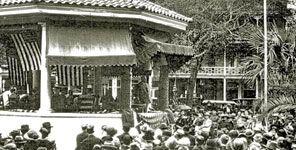
The Mysterious Disappearance of D.P. Davis
Part I of a series
D. P. Davis Comes to St. Augustine
By Geoff Dobson
In the early morning hours of October 12, 1926, the world’s largest ocean liner was steaming eastward from New York. The great ship had encountered a storm. The storm, however, would not delay the passengers in their expected arrival in Southampton.
The steam turbine quadruple screw engines powered by 48 boilers developed 100,000 horsepower and enabled the ship to cruise at 23 knots and attain 25 knots. It was headline news in the New York Times if the ship was even as much as six hours late after passing through an Atlantic hurricane.
The Royal Mail Ship Majestic was the pride of the White Star Line and attracted the rich and famous of the day. Its popularity was such that passage had to be booked as much as a year in advance. A month before, a hurricane had hit Miami with 130 m.p.h. winds.
That hurricane ultimately had an impact on the plans of one of the ship’s passengers; plans which if carried out would have altered forever St. Augustine. Yet in part due to the Miami hurricane and an incident on board the great liner, St. Augustine’s future was changed. Today, historians and writers debate without agreement what occurred.
A year before, the St. Augustine Evening Record headlined “Davis to Develop Here”, David Paul Davis, Sr. was Florida’s most famous developer.
In Tampa, he had developed Davis Island. Lots on Davis Islands had sold out in one day. Davis Island had been dredged up onto two mosquito infested islands with five dredges working day and night. Yacht and tennis clubs were constructed.
A coliseum was designed by world famous designer T. H. Eslick. Eslick had designed ballrooms and amusement parks world-wide including Australia, the United Kingdom, Germany, and Russia. In California, Eslick had designed the La Monica Ballroom on the Santa Monica Pier. One of his major achievements was the Great Dunbar Exhibition constructed in Bombay on the occasion of the visit of the King-Emperor George V in 1911. One-third of the stock in the Coliseum was reserved in one day. The owner of the Tampa Tribune had tried to buy a majority interest, but was refused by Davis.
Davis’ new development in St. Augustine was to be his crowning achievement. The largest dredging contract in the world was let to fill in what is now Davis Shores. Davis Shores would extend from the Inlet south to Fish Island. Construction of a new arched bridge (now the Bridge of Lions) was commenced; replacing the old street railway bridge that previous provided the only access to Anastasia Island.
The Hamblin Mansion (now the American Legion Hall) was acquired and remodeled into a Mediterranean revival style administration building. On the island, a real estate office, later to become the Knights of Columbus hall (now gone), was constructed.
A model of what Davis Shores would look like when completed was displayed in both the Tampa and St. Augustine office. The model featured little gondolas on proposed canals.
A new $250,000.00 yacht club was to be constructed with its own boat basin. There was to be a Roman pool. The center pieces of Davis Shores, however, were to be a magnificent new $1,500,000.00 hotel — similar in design to the Coral Gables’ 26-story Miami-Biltmore Hotel and the beach-front Fort Marion Hotel.
The development would feature two 18-hole golf courses. A smaller hotel would be constructed first, with a boulevard leading straight from the new Bridge of Lions to the entrance to the hotel. The bridge was to be designed by America’s foremost bridge designer, J. E. Greiner.
Offices were opened in various northern cities. On the opening day of sales, $16,268,000 worth of lots were sold. In anticipation of expected growth, the city expanded its city limits. On Anastasia Island, the limits were extended south to about present day Dondenville Road. On the mainland, the expanded city limits reached all of Ravenswood and out to where St. Augustine High School is today.
Next Week: The Bloom comes off the Florida Boom.
Geoff Dobson, a St Augustine resident for the past 32 years, is a western and Florida history writer. He is a former president of the St. Augustine Historical Society and a regular contributor of nostalgic memories to Historic City News. Before his parents moved to Florida, his father was a Black Angus cattleman. Geoff has written extensively on Wyoming history (“Wyoming Tales and Trails”). When Geoff was in high school, his family lived in the cattle country of eastern Sarasota County. The family spread, which his parents called “Wild Cat Slough,” was reachable only by a pair of ruts over the sand hills and through a snake and gator infested slough. Now, it is an area of four-lane roads, expensive subdivisions, shopping centers, and office parks. . His undergraduate degree is in history. Geoff received his post-graduate degree from the University of Florida. He may be reached at horse.creek.cowboy@gmail.com
Discover more from HISTORIC CITY NEWS
Subscribe to get the latest posts sent to your email.
